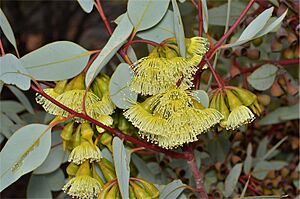Pimpin mallee facts for kids
Quick facts for kids Pimpin mallee |
|
|---|---|
 |
|
| Eucalyptus pimpiniana in the Great Victoria Desert | |
| Conservation status | |
| Scientific classification | |
| Genus: |
Eucalyptus
|
| Species: |
pimpiniana
|
The Pimpin Mallee (scientific name: Eucalyptus pimpiniana) is a special type of shrub that grows in the Great Victoria Desert in Australia. It's found only in this desert, which stretches across parts of South Australia and Western Australia. This plant has smooth, colorful bark and leaves shaped like a spear. Its flowers are yellow, and its fruit looks like a small barrel.
Contents
What the Pimpin Mallee Looks Like
The Pimpin Mallee is a shrub that usually grows up to 2 meters (about 6.5 feet) tall. It has a special woody lump at its base called a lignotuber, which helps it regrow after fires.
Bark and Leaves
- Its bark is smooth and has a mix of colors like salmon pink, grey, and brownish shades.
- Young plants and new shoots have greenish-grey leaves that are shaped like a spear or an egg. These leaves are about 6 to 8 centimeters (2.4 to 3.1 inches) long.
- Adult leaves are a dull bluish-green on both sides. They are also spear-shaped, about 6.5 to 14 centimeters (2.5 to 5.5 inches) long, and have a small stem connecting them to the branch.
Flowers and Fruit
- The Pimpin Mallee's flower buds grow in groups of 7 to 19. Each group sits on a stalk about 1.2 to 3.5 centimeters (0.5 to 1.4 inches) long.
- The mature buds are oval or pear-shaped, about 2 to 3.3 centimeters (0.8 to 1.3 inches) long. They have a beak-like cap on top.
- This plant can flower at different times of the year, but it has been seen flowering in January, July, and October. Its flowers are bright yellow.
- After flowering, the plant produces woody fruits. These fruits are shaped like a cylinder or a barrel, about 1.4 to 2.2 centimeters (0.5 to 0.9 inches) long.
How It Got Its Name
The Pimpin Mallee was first officially described in 1912 by a scientist named Joseph Maiden. He wrote about it in his book, A Critical Revision of the Genus Eucalyptus.
Discovery and Origin of Name
- The plant was found by Henry Deane near a place called Ooldea in 1909.
- Joseph Maiden decided to name it pimpiniana because "pimpin" was the local Aboriginal name for the plant.
Where the Pimpin Mallee Lives
The Pimpin Mallee grows in the southern part of the Great Victoria Desert.
Habitat
- You can find it growing in red sand on sand dunes and flat sandy areas.
- Its range stretches from near Barton in South Australia all the way to Lake Minigwal in Western Australia.
Protecting the Pimpin Mallee
In Western Australia, the Pimpin Mallee is listed as "Priority Three" by the government's Department of Parks and Wildlife.
What Priority Three Means
- This means that not a lot is known about the plant, and it's only found in a few places.
- However, it's not currently in immediate danger of disappearing. Scientists are keeping an eye on it to make sure it stays safe.




